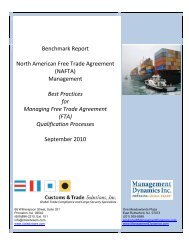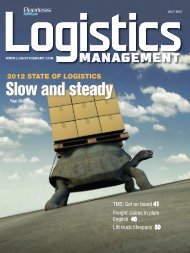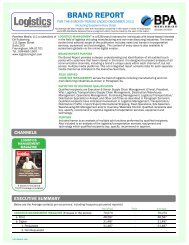Logistics Management - October 2011
Logistics Management - October 2011
Logistics Management - October 2011
Create successful ePaper yourself
Turn your PDF publications into a flip-book with our unique Google optimized e-Paper software.
Evaluating and recognizing carrierperformance is critical for successBy John A. Gentle, DLP<strong>Logistics</strong> <strong>Management</strong>’s 28th Annual Quest for QualityAward winners were announced in the August editionof <strong>Logistics</strong> <strong>Management</strong> magazine. On <strong>October</strong>5th, Michael Levans, group editorial director for LMpresented the awards to the winning companies on thelast evening of CSCMP’s annual meeting in Philadelphia.Congratulations to the winners, and thanks toall of the shippers and receivers who took the time toselect the carriers and rank them based on their serviceperformance.Every time I read stories about recognizing carriersfor overall excellence I think about carriers that I heldin very high esteem, but traditionally didn’t make theQuest for Quality list or other recognition lists. Thereasons are numerous. Certainly the size of the carriermakes a difference, as well as what groups within thecompany measured the carriers. Then there are the criteriato be considered and how the scores are weighed.This article and its rankings are not about whetherthe winners deserved being best in class. Rather it’sabout the importance of the effort that your teamsshould be putting into the evaluation and recognitionof your carrier base. It is a well-known fact thatinspection brings opportunities for improvement, andrecognition is a vital impetus to excellence.Initially, I recall doing performance reviews bymyself that were focused on “service performance,”as this generated the highest degree of visibility inour company. Over time, and as the “quality process”emerged, it became clear that the internal customers ofthe transportation process were numerous and includedcustomer service; contract and rate departments; dispatchteams that tendered loads, handled turnbacks,expedited shipments, and rescheduled late deliveries;warehouses that loaded the trailers and needed toensure the safety of equipment and personnel on andaround the loading docks; freight payment and claimsteams; and finally the transportation management team.The challenge then became how to involve all ofthese teams. We needed to decide what each groupwanted to measure; how it would be measured; howJohn A. Gentle is president of John A. Gentle & Associates, LLC,a logistics consulting firm specializing in contract/relationship managementand regulatory compliance for shippers, carriers, brokers,and distribution centers. A recipient of several industry awards, hehas more than 35 years of experience in transportation and logisticsmanagement. He can be reached at jag@RelaTranShips.com.the parties would participate; the frequency of thereviews; where the reviews would be held; the weightingfor the final score; and how this would be presentedto the carriers.Suddenly this “carrier evaluation process” appearedto be a big project, and there were questions aboutthe overall value of doing performance reviews. Couldthe in-depth review be done only with quantitativemeasurable data? Or was there value in collectingsubjective feedback that could be open to bias andpersonality conflicts.In the end, all internal company teams willinglyparticipated, some with quantifiable information andothers with some simple assessments of whether ornot a carrier company was helpful or a hindrance.For example, questions were prepared to allowteams to rank carriers from 4 to 9 on how well theysolved process problems, responded to informationThe annual and public recognitionof carriers and their successesmust be a vital part of your carriermanagement program.requests, and provided quality information the firsttime. Teams suddenly found it easier to do bothquantitative and subjective evaluations and developa numeric performance profile for the carrier at eachplant and distribution center.In subsequent articles I’ll share information aboutwhat each of our groups measured and how weweighted the overall score. But, we quickly destroyeda commonly held view that a carrier that excels in onearea of the country operates with the same excellenceacross the country. That’s simply not true, and wepursued a program that rated and recognized carrierperformance regionally—or by plant and distributioncenter—and not nationally.The annual and public recognition of carriers andtheir successes must be a vital part of your carrier managementprogram. Not only does it drive consistentlyexceptional performance across all functional areas, butit also sends a clear signal about your company’s interestin investing in your carriers and the industry. Don’tlet a few budget dollars preclude measurement andrecognition. M64 <strong>Logistics</strong> <strong>Management</strong> WWW.LOGISTICSMGMT.COM | <strong>October</strong> <strong>2011</strong>
















